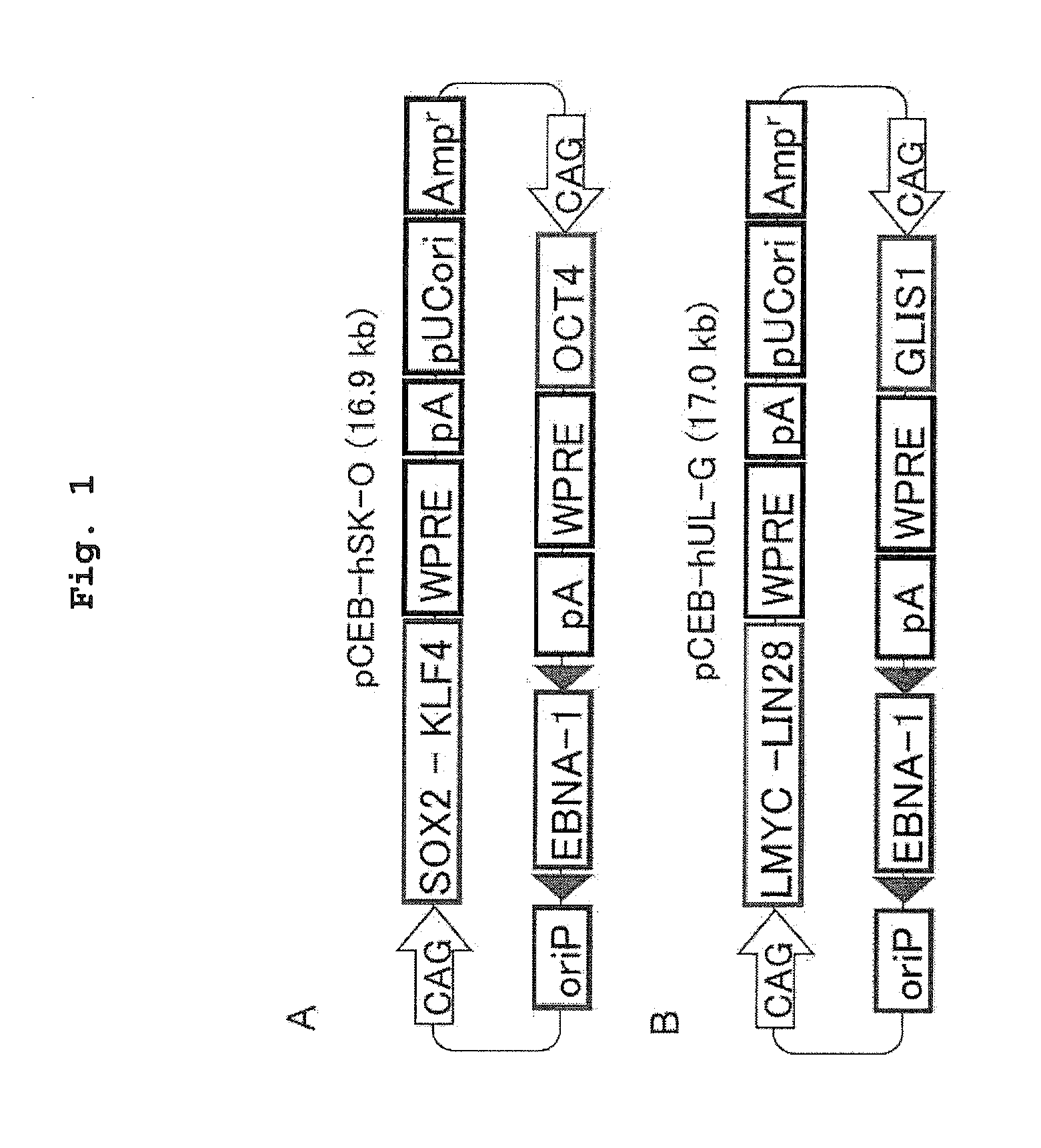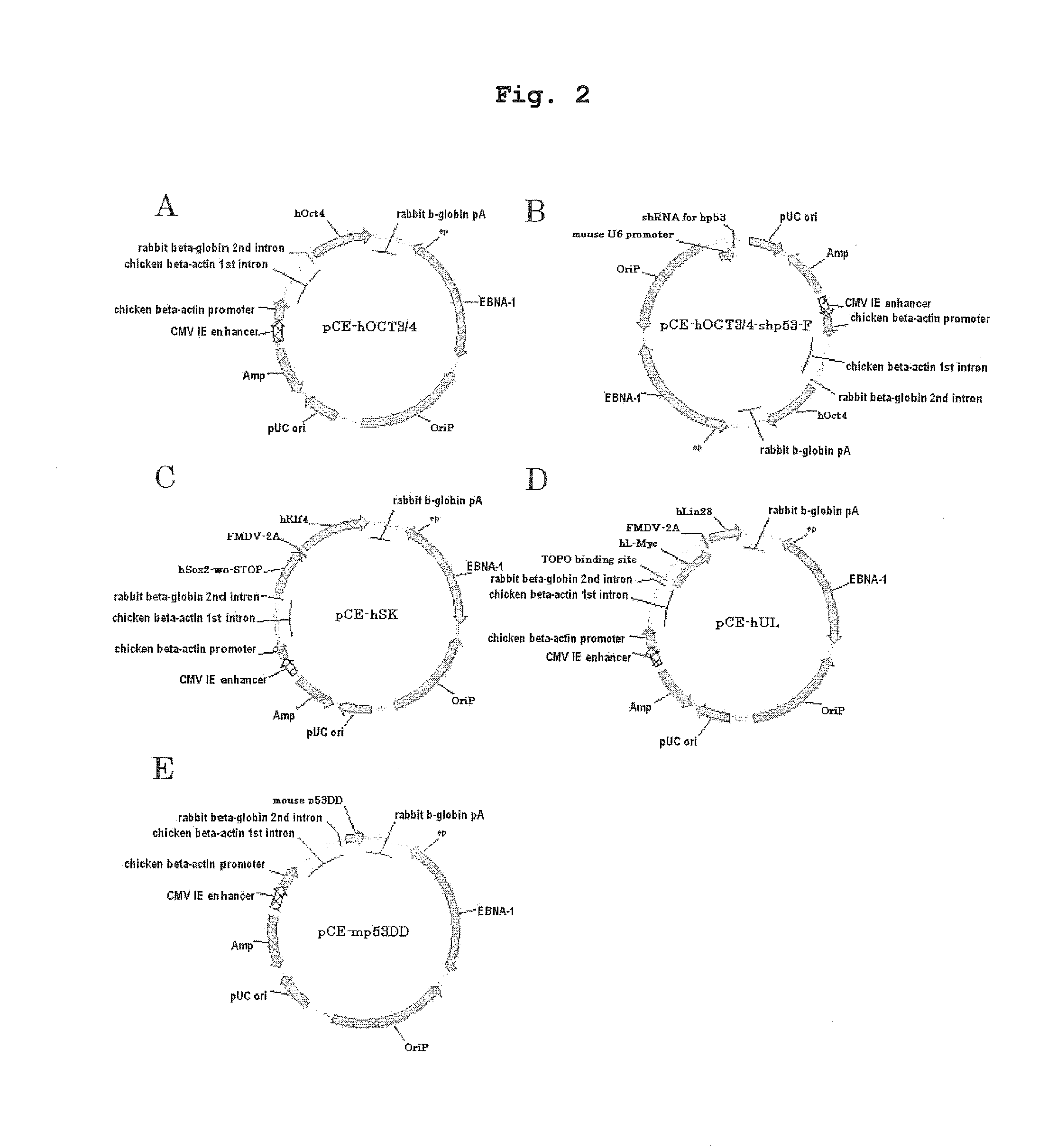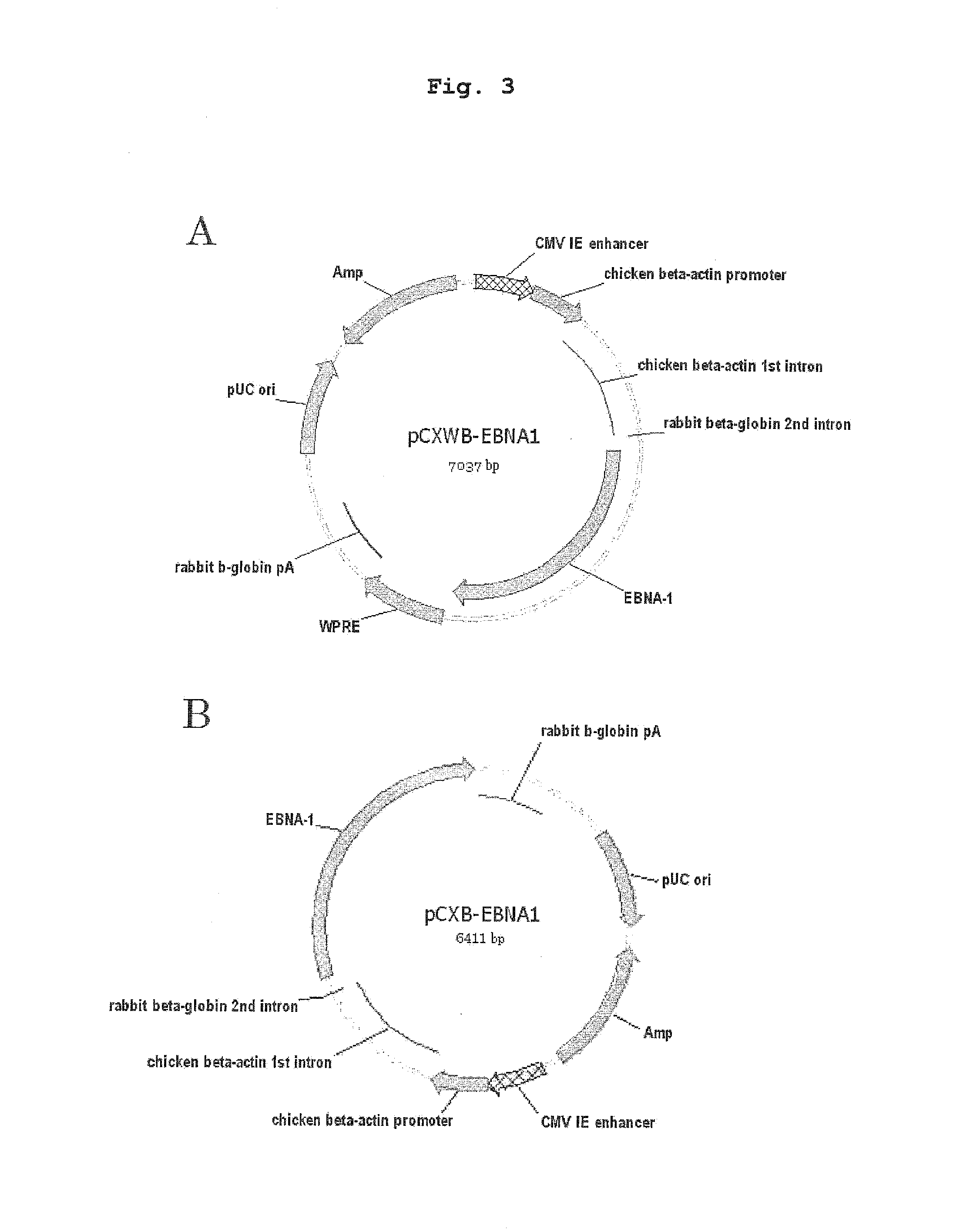Highly efficient method for establishing induced pluripotent stem cell
a high-efficiency, stem cell technology, applied in the direction of genetically modified cells, skeletal/connective tissue cells, peptide sources, etc., can solve the problems of low efficiency of the above-mentioned ips cell establishment, low frequency of spontaneous disappearance of vectors, and method using episomal vectors stably and autonomously replicating outside the chromosome, so as to improve the establishment efficiency of ips cells and facilitate the provision of human ips cells.
- Summary
- Abstract
- Description
- Claims
- Application Information
AI Technical Summary
Benefits of technology
Problems solved by technology
Method used
Image
Examples
example 1
Preparation of Various Episomal Plasmids to be Used for Reprogramming
[0109]Four kinds of plasmids (pCXLE-hOCT3 / 4, pCXLE-hSK, pCXLE-hUL and pCXLE-hOCT3 / 4-shp53-F) used were those produced before (Okita at al., Nature Methods, 8(5), 409-412(2011), WO 2011 / 016588). The outline of the constitution of the respective plasmids is as follows.
1) pCXLE-hOCT3 / 4 (Addgene#27076):
[0110]A plasmid wherein expression cassettes having a translation region of human Oct3 / 4 configured under regulation of CAG promoter (containing WPRE sequence and rabbit β-globin polyA addition signal at the downstream of the translational region, hereinafter the same) are configured in the 5′ to 3′ orientation in this order from the 3′-side of EBNA-1 gene (sense strand) as the origin (hereinafter the same).
2) pCXLE-hSK (Addgene#27078):
[0111]A plasmid wherein expression cassettes having a construct, wherein respective translational regions of human Sox2 and human Klf4 are linked via foot-and-mouth disease virus (FMV) 2A ...
example 2
Production of Extra EBNA-1 Vector Plasmid
[0124]To express transgene efficiently, WPRE sequence was inserted into the 5′-side pA sequence of pCX-EGFP (provided by Dr. Masaru OKABE, Osaka University, FEBS Letters, 407, 313-319, 1997), and further SV40ori was removed by treating with restriction enzyme BamHI. This vector was pCXWB. Then, the EGFP site of pCXWB was removed with EcoRI, and an EBNA-1-coding region, which was amplified from pCEP4 (Invitrogen) by PCR, was inserted instead. This vector was named “pCXWB-EBNA1”, and used in the following experiment (FIG. 3A).
[0125]pCXB-EBNA1, which is other Extra EBNA-1 vector plasmid, was produced as shown below. First, pCX-EGFP was treated with restriction enzyme BamHI to allow for self ligation. This vector was pCXB-EGFP. Then, pCXB-EGFP was treated with restriction enzyme EcoRI, and an EcoRI fragment of pCXWB-EBNA1 (EBNA-1coding region) was inserted to give pCXB-EBNA1 (FIG. 3B).
example 3
Establishment of Human Fibroblast (HDF1419)-Derived iPS Cell
[0126]Using a combination of plasmids (pCEB-hSK-O and pCEB-hUL-G), and a combination thereof with pCXWB-EBNA1, iPS cells were established from human fibroblast (HDF1419).
[0127]Human fibroblasts (HDF1419) were purchased from Cell Applications, Inc. The fibroblasts were cultured and maintained in a culture medium (DMEM (Nacalai Tesque, Japan) supplemented with 10% fetal bovine serum (FCS, Invitrogen)) in a 100 mm culture dish at 37° C., 5% CO2. For introduction of the plasmids, the medium was removed and PBS (5 mL) was added to wash the cells. PBS was removed, 0.25% Trypsin / 1 mM EDTA (Invitrogen) was added, and the mixture was reacted at 37° C. for about 5 min. When the cells floated, DMEM / 10% FCS was added to suspend the cells, and 6×105 cells were collected in a 15 mL centrifugation tube. The cells were centrifuged at 800 rpm for 5 min to remove the supernatant. Each plasmid (1.5 μg, pCXLE-hSK-O and pCEB-hUL-G) was introduc...
PUM
| Property | Measurement | Unit |
|---|---|---|
| time | aaaaa | aaaaa |
| time | aaaaa | aaaaa |
| time | aaaaa | aaaaa |
Abstract
Description
Claims
Application Information
 Login to View More
Login to View More - R&D
- Intellectual Property
- Life Sciences
- Materials
- Tech Scout
- Unparalleled Data Quality
- Higher Quality Content
- 60% Fewer Hallucinations
Browse by: Latest US Patents, China's latest patents, Technical Efficacy Thesaurus, Application Domain, Technology Topic, Popular Technical Reports.
© 2025 PatSnap. All rights reserved.Legal|Privacy policy|Modern Slavery Act Transparency Statement|Sitemap|About US| Contact US: help@patsnap.com



